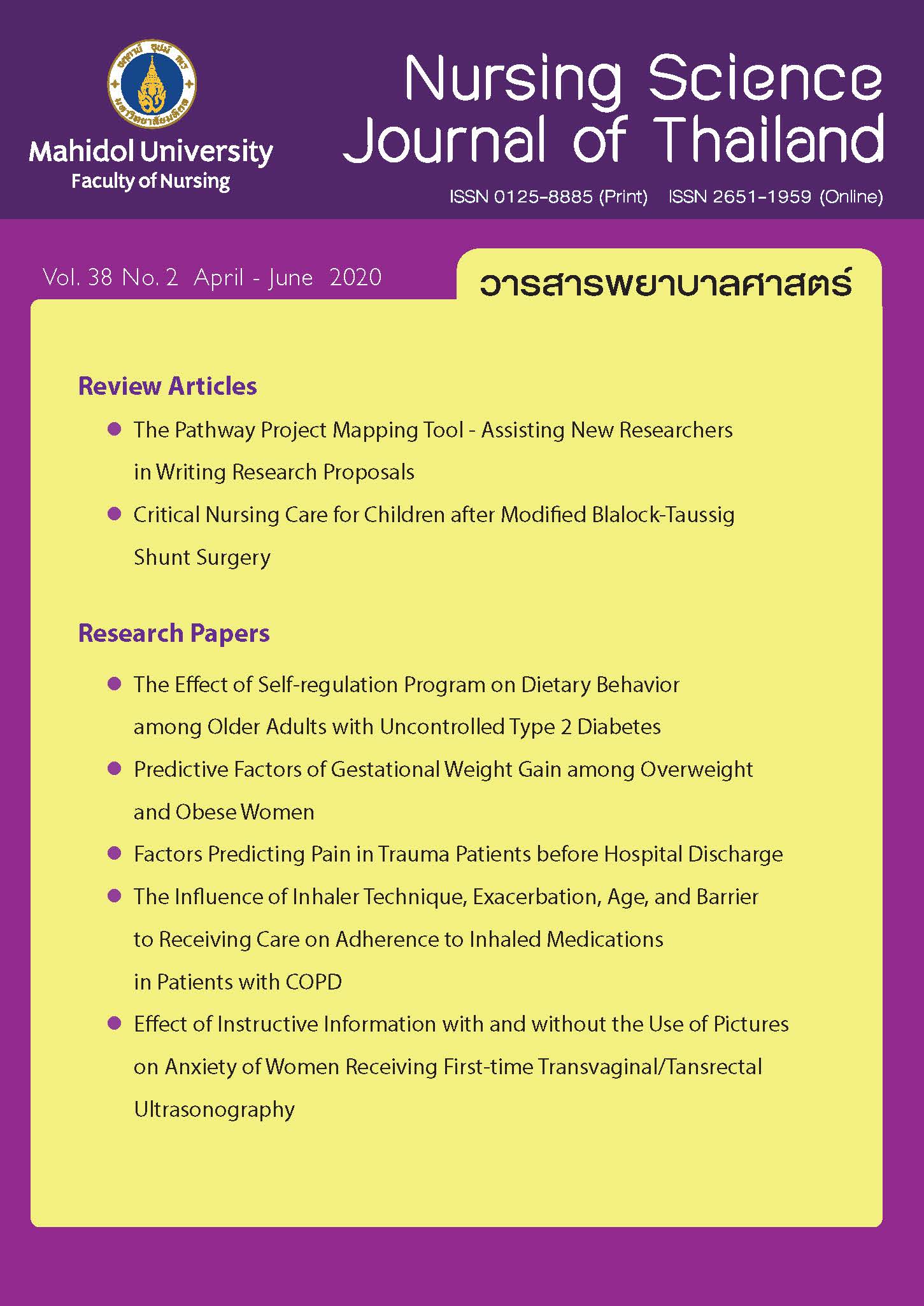การพยาบาลผู้ป่วยเด็กหลังการได้รับการผ่าตัด Modified Blalock-Taussig Shunt (MBTS) ในระยะวิกฤต
Main Article Content
บทคัดย่อ
การผ่าตัด Modified Blalock-Taussig Shunt (MBTS) เป็นการผ่าตัดประคับประคอง (palliative surgery) เพื่อแก้ไขปัญหาเลือดไปปอดน้อยในผู้ป่วยที่มีภาวะหัวใจพิการแต่กำเนิดชนิดเขียว ซึ่งพยาบาลผู้ดูแลผู้ป่วยมีจำเป็นอย่างยิ่งที่จะต้องมีความรู้ความเข้าใจ และทักษะการดูแลผู้ป่วยกลุ่มนี้ให้มีความปลอดภัยจากภาวะแทรกซ้อนหลังผ่าตัด สามารถตัดสินใจแก้ไขความผิดปกติที่เกิดขึ้นหลังผ่าตัดได้อย่างรวดเร็วและถูกต้อง โดยแนวทางการพยาบาล คือ การเฝ้าระวังสัญญาณชีพอย่างใกล้ชิด ลดภาวะแทรกซ้อนสำคัญที่อาจเกิดขึ้น ได้แก่ ความดันโลหิตต่ำหรือภาวะที่หัวใจบีบเลือดออกจากหัวใจได้น้อยลง ภาวะเลือดไปปอดน้อยเกินไป และภาวะเลือดไปปอดมากเกินไป ร่วมกับการให้ความช่วยเหลือและร่วมมือกับแพทย์ในการดูแลรักษา เพื่อเพิ่มอัตราการรอดชีวิตและเพิ่มคุณภาพชีวิตที่ดีขึ้นให้กับผู้ป่วยและครอบครัว
Article Details
ลิขสิทธิ์: วารสารพยาบาลศาสตร์เป็นเจ้าของลิขสิทธิ์ในการเผยแพร่ผลงานที่ตีพิมพ์ ห้ามผู้ใดนำบทความที่ได้รับการตีพิมพ์ในวารสารพยาบาลศาสตร์ไปเผยแพร่ในลักษณะต่างๆ ดังต่อไปนี้ การส่งบทความไปตีพิมพ์เผยแพร่ที่อื่น การนำบทความเผยแพร่ออนไลน์ การถ่ายเอกสารบทความเพื่อกิจกรรมที่ไม่ใช่การเรียนการสอน ยกเว้นเสียแต่ได้รับอนุญาตจากวารสารพยาบาลศาสตร์

Disclaimer: เนื้อหาบทความหรือข้อคิดเห็นใดๆ ในวารสารพยาบาลศาสตร์ ถือเป็นความรับผิดชอบของผู้เขียน กองบรรณาธิการไม่จำเป็นต้องเห็นด้วยและไม่มีส่วนรับผิดชอบแต่อย่างใด
เอกสารอ้างอิง
Somchue N, Sanasuttipun W, Srichantaranit A. The effect of a teaching program on knowledge and behaviors of caregivers to promote nutrition in children with acyanotic congenital heart disease. Journal of Nursing Science. 2016;34(3):79-93. (in Thai).
Thamjamratsri K, Prangvatanagul W. Critical congenital heart disease screening in seonates in Prapokklao Hospital. Journal Prapokklao Hospital Clinic Medication Education Center. 2019;36(2):134-41. (in Thai).
The Society of Thoracic Surgeons of Thailand. Statistical statistics for heart surgery in Thailand from 2001 - present [Internet]. Bangkok: The Society of Thoracic Surgeons of Thailand; 2005 [cited 2019 Dec 20] Available from: https://thaists.org/news_detail.php?news_id=212. (in Thai).
NHS Greater Glasgow and Clyde. Modified Blalock-Taussig Shunt (MBTS), immediatepost-operative management [Internet]; Glasgow Scotland: NHS Greater Glasgow and Clyde; 2020 [cited 2019 Dec 20] Available from: https://www.clinicalguidelines.scot.nhs.uk/ggc-paediatric-guidelines/ggc-guidelines/cardiovascular-diseases/Modified-blalock-taussig-Shunt-mbts-immediate-post-operative-management/
Kiran U, Aggarwal S, Choudhary A, Uma B, Kapoor PM. The Blalock and Taussig shunt revisited. Ann Card Anaesth. 2017;20(3):323-30. doi: 10.4103/aca.ACA_80_17.
Petrucci O, O’Brien SM, Jacobs ML, Jacobs JP, Manning PB, Eghtesady P. Risk factors for mortality and morbidity after the neonatal Blalock-Taussig shunt procedure. Ann Thorac Surg. 2011;92(2):642–51. doi: 10.1016/j.athoracsur.2011.02.030.
McKenzie ED, Khan MS, Samayoa AX, Vener DS, Ishak YM, Santos AB, et al. The Blalock-Taussig shunt revisited: a contemporary experience. J Am Coll Surg. 2013;216(4):699-704. doi: 10.1016/j.jamcollsurg.2012.12.027.
Shahidi M, Bakhshandeh H, Rahmani K, Afkhamzadeh A. Hypomagnesaemia and other electrolytes imbalances in open and closed pediatrics cardiac surgery. Pak J Med Sci. 2019;35(2):353–9. doi: 10.12669/pjms.35.2.367.
Polderman KH, Girbes AR. Severe electrolyte disorders following cardiac surgery: a prospective controlled observational study. Crit Care. 2004;8(6):R459–66. doi: 10.1186/cc2973.
Colson PH, Gaudard P, Fellahi JL, Bertet H, Faucanie M, Amour J, et al. Active bleeding after cardiac surgery: a prospective observational multicenter study. PLoS One. 2016;11(9):e0162396. doi: 10.1371/journal.pone.0162396.
Perez Vela JL, Martín Benitez JC, Carrasco Gonzalez M, de la Lopez MA, Hinojosa Perez R, Sagredo Meneses V, et al. Summary of the consensus document: “clinical practice guide for the management of low cardiac output syndrome in the postoperative period of heart surgery”. Med Intensiva. 2012;36(4):277-87. doi: 10.1016/j.medin.2012.01.016.
Li JS, Yow E, Berezny KY, Rhodes JF, Bokesch PM, Charpie JR, et al. Clinical outcomes of palliative surgery including a systemic-to-pulmonary artery Shunt in infants with cyanotic congenital heart disease: does aspirin make a difference? Circulation. 2007;116:293-97.
Lok JM, Spevak PJ, Nichols DG. Tricuspid atresia. In: Nichols DG, Lok JM, Spevak PJ, Nichols DG, editors. Critical heart disease in infants and children. Philadelphia: Mosby Inc; 2010. p.806-7.
Peter D. Post operative cardiovascular dysfunction pharmacologic support. In: Lake CL, Booker PD, editors. Pediatric cardiac anesthesia. 4th ed. Philadelphia: Lippincott Williams and Wilkins; 2005. p.654-81.
NHS Greater Glasgow and Clyde. Cardiac post-op patients: anti-coagulation therapy in PICU [Internet]. Glasgow, Scotland: NHS Greater Glasgow and Clyde; 2020 [cited 2019 Aug 17]. Available from: https://www.clinicalguidelines.scot.nhs.uk/ggc-paediatric-guidelines/ggc-guidelines/cardiovascular-diseases/cardiac-post-op-patients-anti-coagulation-therapy-in-picu/
Ismail SR, Almazmi MM, Khokhar R, AlMadani W, Hadadi A, Hijazi O, et al. Effects of protocol-based management on the post-operative outcome after systemic to pulmonary shunt. Egypt Heart J. 2018;70(4):271–8. doi: 10.1016/j.ehj.2018.09.007.
Kuck M, Ozdemir R, Karacelik M, Doksoz O, Karadeniz C, Yozgat Y, et al. Risk factors for thrombosis, overshunting and death in infants after modified blalock-taussig shunt. Acta Cardiol Sin. 2016;32(3):337-42.
Kim KH, Oh KY. Clinical applications of therapeutic phlebotomy. J Blood Med. 2016;7:139–44. doi: 10.2147/JBM.S108479.
Marchioli R, Finazzi G, Specchia G, Cacciola R, Cavazzina R, Cilloni D, et al. Cardiovascular events and intensity of treatment in polycythemia vera. N Engl J Med. 2013;368(1):22–33. doi: 10.1056/NEJMoa1208500.


